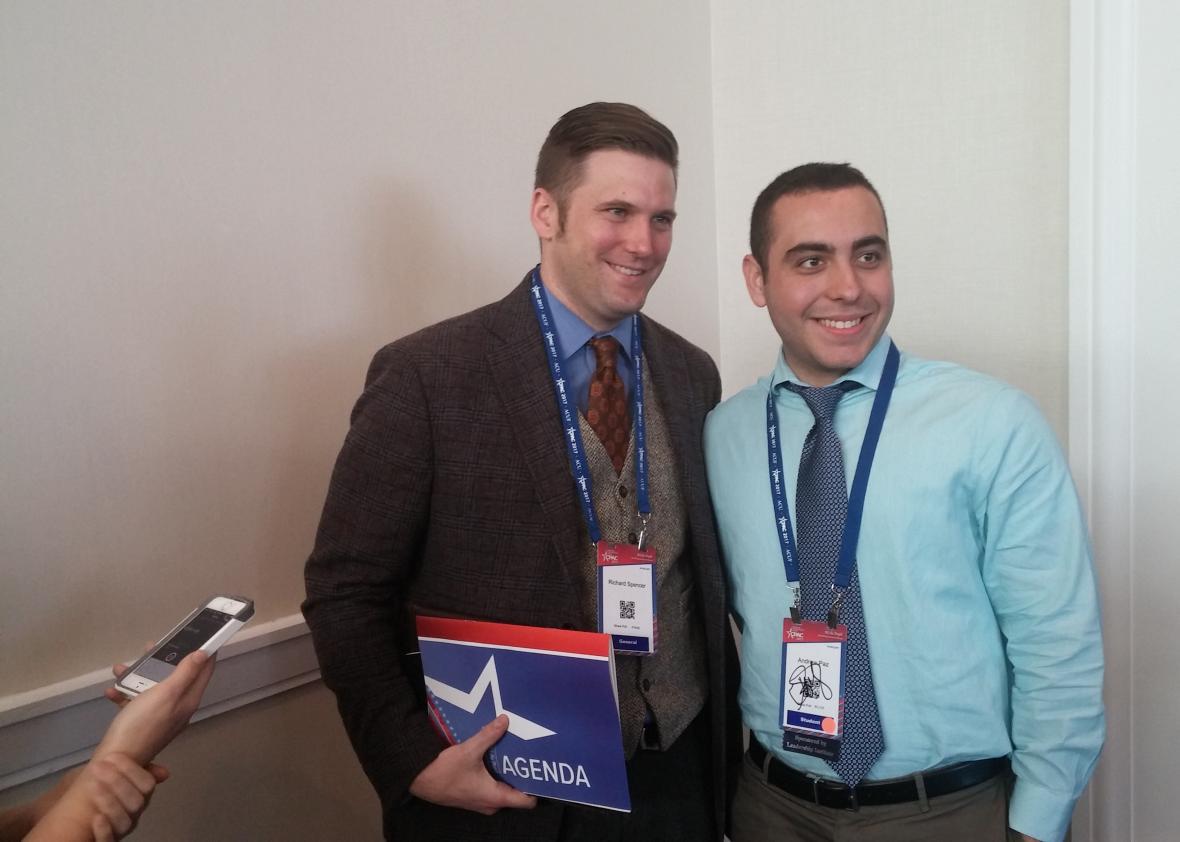NATIONAL HARBOR, Maryland—Early on the second day of the Conservative Political Action Conference—the country’s largest annual gathering of the political right—Dan Schneider delivered an almost paternalistic lecture about dark, seductive forces afoot at his event. The executive director of the American Conservative Union, the group that organizes CPAC, started as parents often do by telling a story. A friend of his who worked in the Treasury Department had one time illuminated for him how to spot phony money.
“My friend explained to me that the way to identify a counterfeit is by looking only at the real deal,” Schneider explained. The training agents went through consisted of being shown, over a period of weeks, an endless stream of real currency. “When that counterfeit bill is slipped in it’s like a slap in the face,” he said. “It’s just so obvious and apparent.”
At that point, Schneider’s voice dropped ominously. “CPAC, we have been slapped in the face,” he said. “There is a sinister organization that is trying to worm its way into our ranks. And we must not be duped and we must not be deceived. This is serious business.”
The “organization” Schneider was describing was the “alt-right”—a name stolen, he claimed, by “left-wing fascists” from bona fide conservatives who had used the label for a long time. “They did it intentionally because they wanted to deceive the media and they wanted to deceive you all about what they stand for, so they can try to become normalized,” he said. “Hateful, left-wing fascists are not like anyone here,” he concluded. Who exactly these left-wing fascists were was left unclear. Presumably he did not mean the president’s top adviser and aide, Steve Bannon, who was invited to speak at CPAC later on Thursday and has proudly described his site, Breitbart, as “the platform for the alt-right.”
Maybe he meant another avatar of that movement. As it happens, one of the people sitting not too far from the stage during Schneider’s speech was alt-right leader and white supremacist icon Richard Spencer. During the speech, Spencer tweeted indignantly that he had invented the term alt-right, a contention he would take to what started as a small gaggle of reporters just outside of the conference’s main ballroom. He told these reporters he wished there’d been a question and answer section with Schneider. “Do they grant a white person the moral legitimacy to stand up for himself? To have an identity?” I would ask that,” Spencer said. “Are you morally opposed to white people understanding themselves?
“What the alt-right is doing is clearly resonating with people,” he continued. “It’s clearly resonating with young people. And so you can basically call it names or you can ask what’s going on. Like why does a young white person feel alienated in the modern world?”
Not long after Spencer stepped out of the ballroom, he was spotted by two young white people, one of whom jumped and nearly squealed to his friend with glee.
“It’s him!” the fan exclaimed. This was J.P. Sheehan, a College Republicans president at an undisclosed New England school. “He’s, like, the coolest guy.” Out of nowhere, Sheehan, in a black Make America Great Again cap, produced a T-shirt sold by Spencer’s Radix Journal and waved it in front of Spencer to get his attention.
A few other young attendees then quickly recognized Spencer and approached him for photos, and the gaggle of reporters quickly and exponentially grew. Within minutes, Spencer was the center of a press mob that blocked passage through the hallway. As security tried to keep the crowd under control, puzzled attendees peered to get a glimpse at who’d stolen the show from the four Republican governors who had by then taken the stage. Perhaps a senator. Maybe Trump. A few caught a glimpse of Spencer, recognized him, and rendered diverging assessments to their companions.
That’s my boy, Ricky Spence!
What a scumbag.
Hang on, I want a picture.
You’re a joke, Spencer!
Fascist!
Spencer took questions from the press for nearly an hour and a half. At one point, Matt Schlapp, the president of the ACU who would later moderate that panel with Bannon, came out to try to draw the press’ attention away from Spencer. He largely failed. I asked Schlapp, who came under fire over the weekend for initially standing by his invitation of then Breitbart tech editor Milo Yiannopoulos to the conference, whether Spencer would be asked to leave. Schlapp would not say. “Look, this is America, and we have to deal with the laws,” he replied obliquely. “All I can tell you is that if he had comments that we’d agree with, he’d be on our stage. And he’s not on our stage.”

Osita Nwanevu
At around 11:20 a.m., though, Spencer—still surrounded by reporters—was asked to give up his credentials and leave. Security told New York magazine’s Olivia Nuzzi—with clarity that had eluded Schlapp—that Spencer’s views denied him a place at CPAC even though he had bought a ticket.* Shortly after this, a speaker took the main stage to explain how Muslim student organizations were working to import jihadist ideology to the United States—highlighting, almost comically, the xenophobia that has drawn some from the right wing into Spencer’s movement.
Not long before being booted, Spencer remarked on the reception he’d received.
“I feel very welcome here,” he told a reporter. “Nobody’s punching me yet.”
*Correction, Feb. 24, 2017: This article originally misstated that Olivia Nuzzi is employed at the Daily Beast. She is now Washington correspondent for New York magazine.
